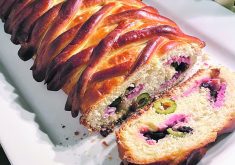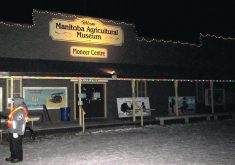Knitting is a classic farm tradition, often the birthplace of many Christmas gifts. Many knitters, as they marvelled at the creations growing in their hands, have wondered how knitting was invented.
Most historians agree it originated from nomads in the Arab world.
Lela Nargi stated, in Knitting Around the World, “Arabic knitting is a generic term. It covers the earliest known types of knitting that were carried out by Nomadic people living in the desert places of North Africa who were, as far as we are aware, the first knitters and are probably antecedents of the Arabs of the present time.
The earliest known specimens of this type of knitting were all worked on frames. The frames were circular or narrow oblong ones; the circular frames being used mainly for knitting sandal socks, the narrow oblong ones for carpets, tent flaps, and possibly articles of clothing.”
This method can be compared to today’s spool knitting on an expanded scale. Early examples were made of silk.
Nargi said the back-and-forth knitting we know today didn’t emerge until almost 1600. The first knitting needles were hooked, and hooked needles were used in Europe until the middle of the 19th century.
Believed to be imported into Spain during the crusades, knitting was favoured over weaving because of its portability, not needing a loom. Over centuries, it spread across Europe as a fitting occupation for small spaces and while travelling. By the 18th century, knitting was everywhere and almost everything was knitted: trousers, shawls, even carpets.

The purl stitch is a basic part of knitting today but didn’t appear until around 1562 in a pair of silk stockings from Spain.
Knitting appears in art with paintings of women knitting, even the “knitting Madonnas,” which still sparks debate over the significance of knitting at the time, but it occupied a large part of daily life.
From its earliest history, farm families used their homespun fibres to create clothing for themselves or sell to supplement their income. In Italy and France, it was the custom of all sexes to knit, even while walking to run errands, with their basket over their forearm.

All over Europe, girls knit during the long, summer days while watching their livestock in pasture on the hills. In winter, they might gather in a koffeeklatsch, sharing lamp light and each other’s company.
Individual styles and processes developed in each area. The spirit of competition held by thousands of knitters created a wealth of designs.
Today, some knitters can identify the area where each design originated, and patterns are named after the area or event where they were designed: the twisted stitch method or Alpine knitting from southern Germany and northern Austria, the incredibly delicate Shetland lace from the Shetland Islands, or the colourful and intricate Fair Isle knitting from the island of that name.
The exact place, time, and designer can rarely be identified as the starting point of a particular pattern, but the Selbu knitting style called Selbuvotter is recorded as designed by Marit Guldseth Emstad in 1856, a farm girl from the Selbu area of Norway. She experimented until she had perfected her signature design of a white background and intricate designs of birds, reindeer, stars, or roses in black. It became so popular it is now a national Norwegian tradition. In North America, the Selbu design is called the Norwegian style.

Knitting became an industry all over Europe, giving extra income to the poor. Knitting guilds formed first in France in 1268 and then reached the Netherlands and Spain.
They improved standards by teaching knitting, defining standards, and helping with sales. Knitters had to pass an exam, producing a high standard of work in a short amount of time. Knitters strove to become master knitters capable of producing the most important article, the knitted carpet.
Carpets incorporated up to 20 colours and measured 6.5 by 10 feet, portraying Bible scenes, scripture texts, or portraits of nobles demonstrating clear evidence of the advanced skill of the knitter.
England is noted for the inception of the knitted sock, replacing the customary cloth sock of those times. England is also known for perhaps the most significant development in the history of knitting: the invention of the knitting frame by William Lee in 1589, which enabled mass production of knitted articles.
Compared to knitting, crochet is a relatively young fibre art, not appearing until the 19th century. The mother of crochet is said to be Mademoiselle Riego de la Branchardiere, the daughter of a French father and Irish mother. At age 18, she published her first book of crochet patterns. An early name for crochet was Irish knitting.
The First World War caused a shift from only making household articles to knitting for the troops followed by a postwar craze for sweaters (not a fashion for non-seafaring folk), bathing suits, designer knitwear, and knitting for charity until anyone who chose to could knit anything at all.
Since at least the Second World War, women have gathered in social knitting groups to knit and talk, sometimes calling the gatherings stitch ‘n bitch. Author Anne Macdonald used the term in her 1980s book, Social History of American Knitting, and partly because of the book’s success, stitch ‘n bitch groups rose in popularity and spread worldwide.
Today, some groups meet online. Other groups of women meet to crochet, embroider, cross-stitch, or do other needle crafts together while “solving the world’s problems”.

Carla Meijsen, founder of Stitch ‘n Bitch Netherlands wrote, “In the 1970s, teachers stopped teaching knitting in Dutch schools… Even then, the way of knitting was getting more modern, so we used larger needles and acrylic yarn in bright colours… in the 1990s, almost nobody knit. I think that we lost a lot of abilities with all crafts in this period.

For example, in knitting, we don’t use very thin needles anymore; we knit with yarns that are easier to use in comparison to the thin cotton of previous eras and we don’t use a lot of intricate patterns. Also, I think most of us lost the ability to work quickly. We are proud to knit a pair of socks in a week but in earlier days, people seemed to have knit long hours and speed was an issue. Compared to the old ways of knitting, all kinds of aspects have changed.”
All kinds of needlework saw a resurgence during the COVID-19 lockdown. While it’s not the daily practice of former eras, it’s common for someone to receive a toque or scarf lovingly knit or crocheted and given as a birthday or Christmas present. Being homemade adds value to the item while reducing the monetary cost for the gifter. Also, the return of a demand for natural fibres increases the focus and the proceeds for farm-raised yarn.















